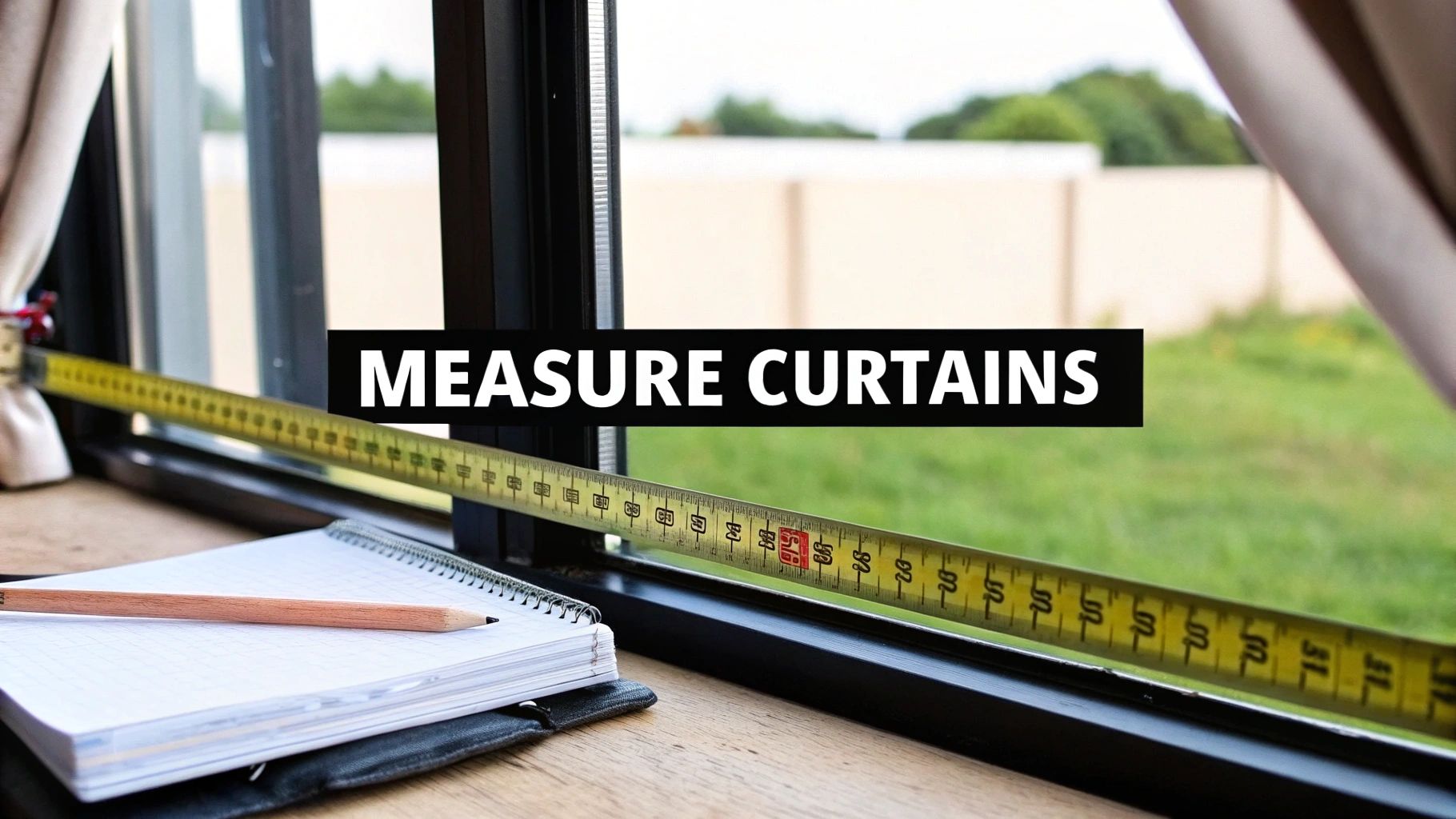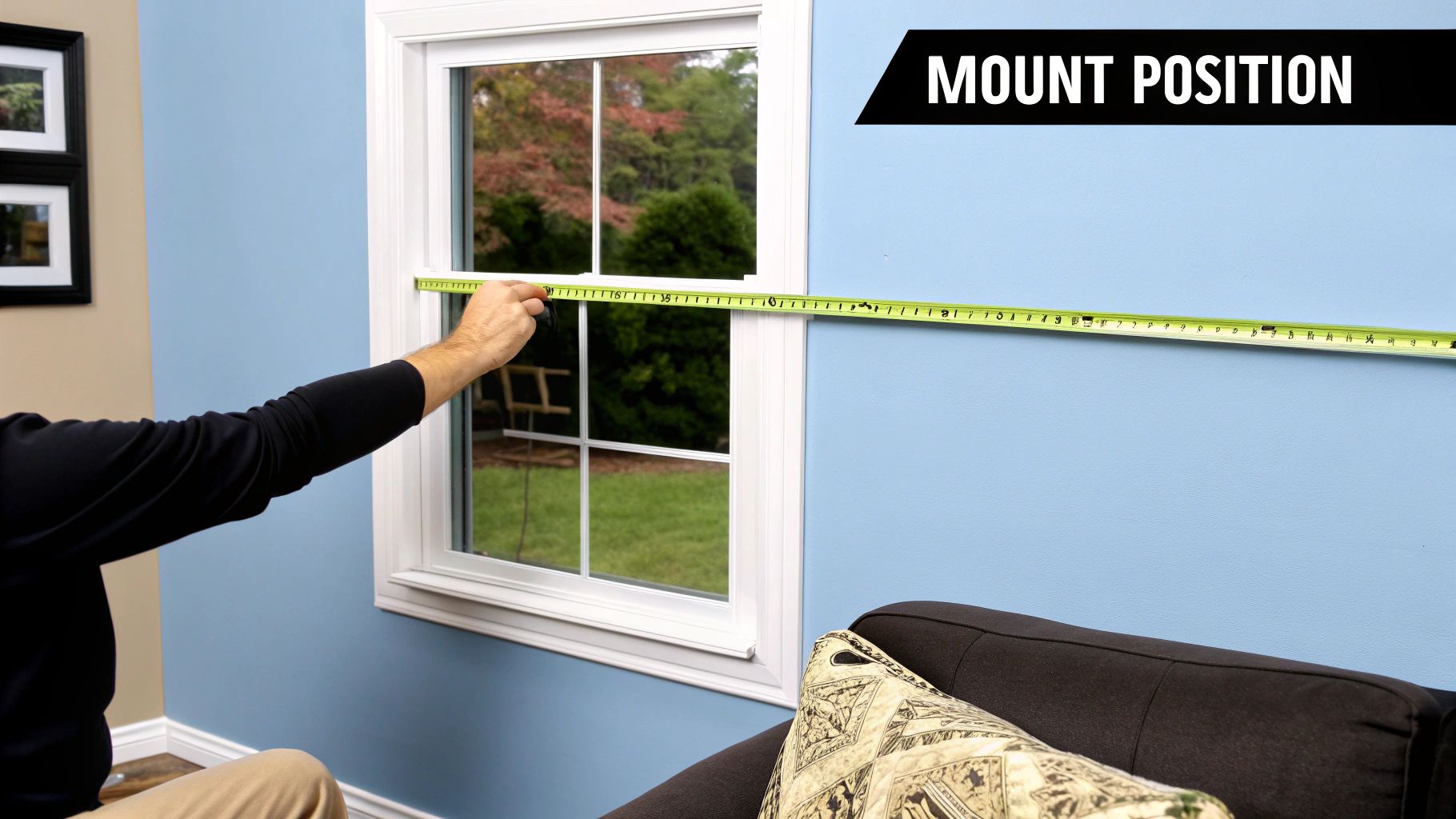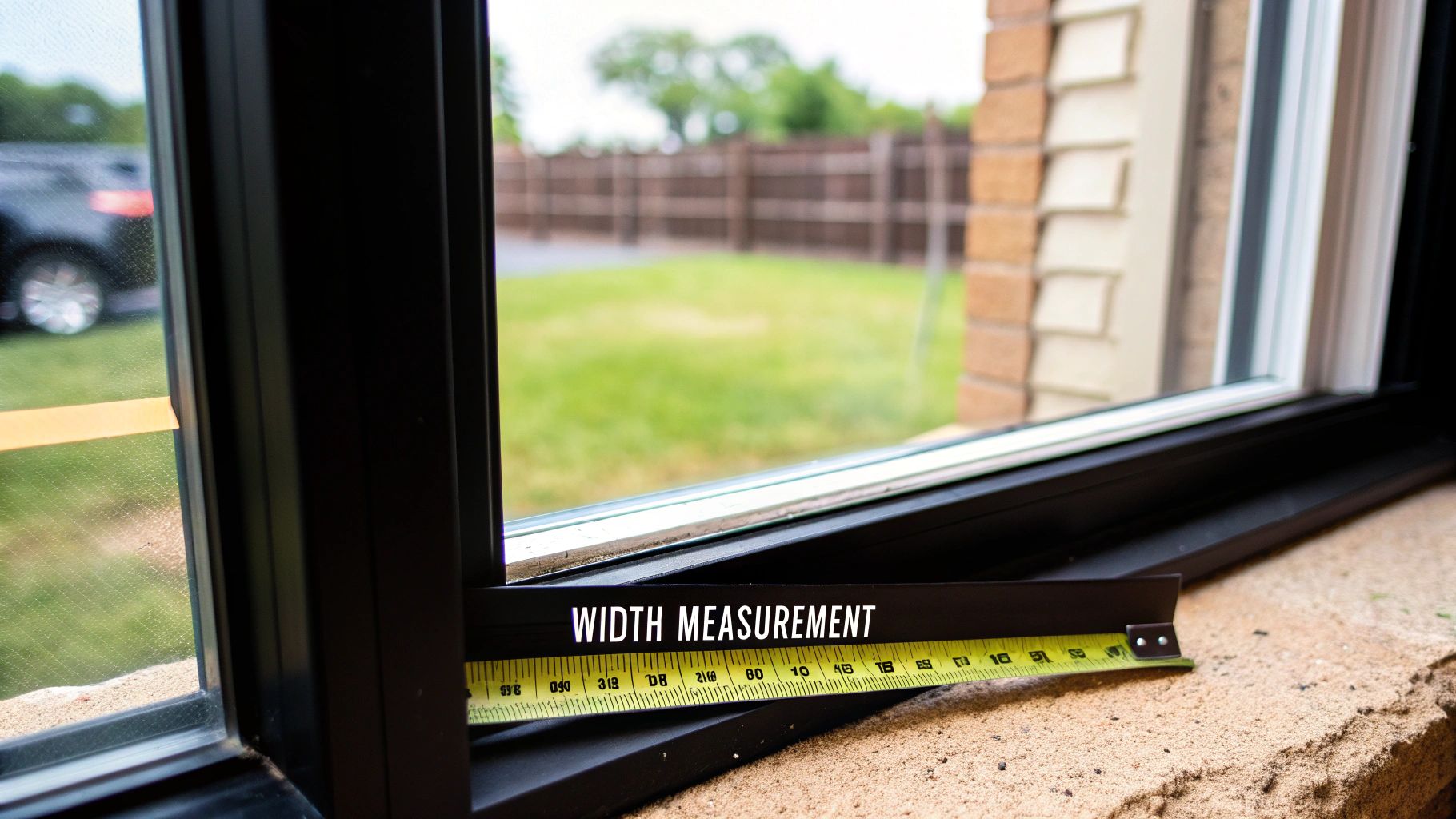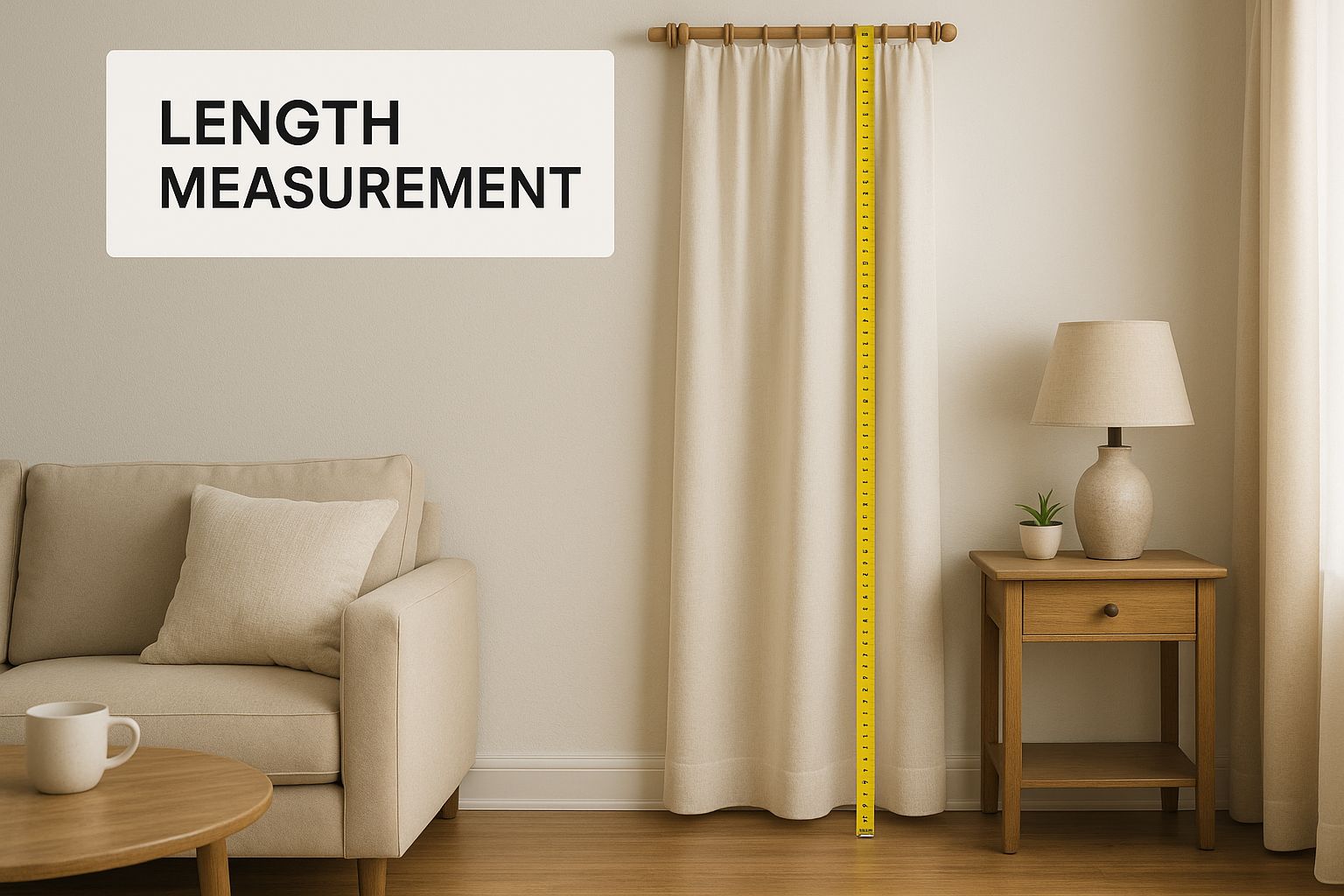How to Measure Curtains: Easy Step-by-Step Guide

Why Proper Curtain Measurements Transform Your Space

Let's face it, well-fitted curtains can dramatically elevate a room's appearance. Conversely, ill-fitting curtains can detract from the overall aesthetic and even impact their functionality. Accurate measurements are essential for achieving the desired look and performance.
The Visual Impact of Precisely Measured Curtains
The right curtain measurements can significantly enhance the visual appeal of your space. Curtains that are too short often make a room feel smaller and unbalanced. Overly long curtains, on the other hand, can look messy and pool on the floor. This is especially relevant in New Zealand homes, where window sizes and styles can vary considerably. Accurate measurements create a polished, designer look, enhancing the entire room.
Functionality and Efficiency
Beyond aesthetics, correct measurements are crucial for your curtains to function effectively. The correct width allows for full closure, ensuring privacy and optimal light control. Getting the drop (length) right ensures effective insulation, helping to retain warmth during New Zealand winters.
This can improve energy efficiency and potentially reduce power bills. Properly fitted curtains also protect furniture and carpets from sun damage by blocking harmful UV rays.
Adding Value and Creating a Professional Finish
Investing in properly measured curtains adds value to your property. When selling, details like well-fitted window treatments can greatly influence buyer perception. Accurate measurements are key to achieving both the desired aesthetic and functionality.
In New Zealand, standard curtain pair widths are typically 210cm and 280cm. This refers to the combined width after hemming. It's generally recommended to extend the curtain track or pole at least 20cm beyond the window frame on each side. This allows the curtains to be fully drawn without blocking the window. This ensures your curtains clear the window effectively and contributes to a well-maintained, stylish impression. Learn more about curtain measuring best practices.
These seemingly small details contribute to a polished, "magazine-worthy" finish. By taking the time to measure accurately, you create a space that is not only beautiful but also functional and valuable.
Essential Tools and Prep Work for Perfect Measurements

Before you begin measuring for curtains, taking the time to gather the necessary tools and prepare your windows is paramount. This ensures accurate measurements, saving you from potential frustration later. Think of it like preparing to bake a cake; having all the ingredients assembled beforehand is essential for success.
Gathering Your Toolkit
Professional installers rely on a few key tools. A steel measuring tape is indispensable. Avoid cloth or plastic tapes as they can stretch, leading to inaccurate measurements.
A pencil and notepad are also vital for jotting down measurements. For high windows, a sturdy stepladder is essential. And finally, an extra set of hands can simplify the process, particularly for long curtains or complex window configurations.
Preparing Your Windows
Next, remove any existing window treatments. This ensures you're measuring the window opening itself, not the old blinds or curtains, which can significantly affect your measurements.
Clear any furniture away from the window area. This provides an unobstructed measurement zone and prevents inaccuracies. This preparation might seem minor, but it greatly improves the precision of your measurements. These initial steps pave the way for accurate measurements.
Considering Curtain Style
Your chosen curtain style influences how you measure. Different heading styles, such as eyelet, pencil pleat, or tab top, require distinct approaches to measuring width and length.
For instance, eyelet curtains require measuring from the inside top edge of the eyelet, while pencil pleat curtains are measured from the top of the track or pole. Grasping these nuances early on is key. For a deeper dive, check out our guide on how to master curtain selection and installation. With your tools gathered, windows prepared, and curtain style considered, you're ready for accurate measurements.
Mastering Curtain Width: Beyond Basic Measurements
Before diving into the world of curtains, refreshing your window treatment knowledge can be beneficial. A guide on how to measure for blinds provides a helpful foundation. Now, let's focus on curtain width, a seemingly simple measurement that can significantly impact your final result.
Tracks Versus Poles: Understanding the Difference
Choosing between tracks and poles is a crucial first step. This decision influences your measuring method and ultimately affects how your curtains fit. Tracks are usually recessed and hidden, while poles are a visible, decorative element.
For track-mounted curtains, measure the entire track length, including overlaps. Pole measurements should be taken between the finials (decorative end pieces). This ensures accurate width calculations for your chosen hardware.
Fullness Ratios: The Secret to Luxurious Curtains
Once you have your window width, consider fullness. This refers to the ratio of fabric width to the track or pole width. Fullness dictates how gathered or pleated your curtains will look. Insufficient fullness can result in a flat, unappealing appearance.
A fullness ratio of 2 to 2.5 times the window width is typically recommended for gathered styles like pencil pleat or pinch pleat curtains. This creates a luxurious, flowing look.
Adjusting for Fabric and Style
The ideal fullness ratio can vary depending on the fabric and the desired style. Heavier fabrics, such as velvet or linen, might need less fullness. Sheer fabrics might benefit from a higher ratio for a more dramatic drape.
For example, eyelet curtains often require less fullness than gathered styles. When measuring, also consider stacking space, the area where the curtains rest when open. Adding 30-40cm to the total width is generally recommended for adequate coverage. Briscoes NZ suggests even adding up to 600mm (300mm per side) for a standard setup, especially for one-sided stacking. This improves appearance and manages light and fading.
To help visualize curtain width calculations, refer to the table below:
Curtain Width Calculation Guide for Different Window Types
This table shows how to calculate the appropriate curtain width based on window size and curtain style preferences for NZ homes.
| Window Width | Curtain Style | Fullness Ratio | Additional Width for Stacking | Total Curtain Width |
|---|---|---|---|---|
| 150cm | Pencil Pleat | 2.5 | 60cm | 435cm |
| 180cm | Eyelet | 2 | 40cm | 400cm |
| 200cm | Pinch Pleat | 2.2 | 60cm | 500cm |
| 120cm | Eyelet | 1.8 | 30cm | 246cm |
| 240cm | Pencil Pleat | 2.5 | 80cm | 680cm |
This table provides examples of how to calculate total curtain width based on different window widths, curtain styles and fullness ratios. Remember to add extra width for stacking to ensure proper functionality and appearance.
Handling Challenging Window Scenarios
New Zealand homes often have unique window designs. Bay windows, with their angled configurations, require careful segmenting. Corner windows also present challenges, making individual measurements essential.

This infographic highlights the importance of accurately measuring the drop, or length, of your curtains. Proper length measurement determines how the curtains hang, whether skimming the floor, falling to the sill, or puddling.
For large picture windows, using multiple panels can achieve the desired fullness and provide greater light control flexibility. Even seemingly straightforward windows in older Kiwi homes, with their potential uneven frames, can present issues. Always double-check measurements and account for irregularities for a perfect fit.
Perfecting Curtain Length: The Secret to Designer Results
Achieving a polished look with your curtains depends heavily on accurate length measurements. This seemingly small detail can dramatically impact a room's overall aesthetic. In New Zealand homes, four distinct curtain lengths are most common, each offering a unique style and functionality.
Understanding Your Length Options
-
Sill-Length: This classic choice falls about 1cm above the window sill. This crisp look works well in traditional spaces and smaller rooms. It’s also a practical solution for windows near furniture or radiators, maximizing space and airflow.
-
Below-Sill: Offering more coverage and a softer feel, these curtains extend approximately 15cm below the sill. This length provides good radiator clearance in New Zealand homes and is a popular option for kitchens and bathrooms.
-
Floor-Length: This elegant option just grazes the floor. A versatile choice suitable for most rooms, it creates a clean, modern look. Floor-length curtains are ideal for enhancing the sense of height and spaciousness, especially in New Zealand homes with lower ceilings.
-
Puddle-Length: For a touch of drama and luxury, puddle-length curtains extend onto the floor, creating a "puddle" of fabric. This opulent style adds grandeur to formal living rooms or bedrooms. However, it may not be ideal for high-traffic areas in Kiwi homes.
Measuring for Success: Tracks vs. Poles and Heading Styles
Accurately measuring your curtains is essential. Whether you’re using a track or pole significantly impacts your measurements. For tracks, measure from the top of the track to your desired length point. For poles, measure from the top of the ring to the desired length. You might find helpful tips in this article on measuring the width of sliding doors.
The heading style of your curtains – eyelet, pencil pleat, or tab top – also affects the measurements. Each heading adds a different amount of fabric above the rod or track. Learn more about curtain and blind selection. Remember to account for this difference to avoid curtains that are too short or too long.
New Zealand Considerations: Airflow, Furniture, and Quirky Architecture
New Zealand homes often present unique challenges when measuring for curtains. Consider airflow around heat sources, ensuring your curtains don't obstruct radiators or heat pumps. Also, consider furniture placement; curtains should clear any obstacles like couches or bedside tables.
In New Zealand, purchasing or installing tracks or poles before measuring is recommended. This ensures accurate measurements, as the final track or pole position determines the needed curtain size. Custom-made curtains, a popular choice in NZ, require precise measurements for a perfect fit.
The table below offers a helpful overview of standard curtain lengths commonly used in New Zealand homes. Explore this topic further.
Standard Curtain Lengths in New Zealand
| Length Style | Measurement Point | Common Use | Aesthetic Effect | Practical Considerations |
|---|---|---|---|---|
| Sill-Length | 1cm above window sill | Kitchens, bathrooms, small rooms | Crisp, tailored | Maximizes space and airflow |
| Below-Sill | 15cm below window sill | Bedrooms, living rooms | Soft, relaxed | Radiator clearance |
| Floor-Length | Just grazes the floor | Most rooms | Elegant, modern | Creates height, suits sliding doors |
| Puddle-Length | Extends onto the floor | Formal living rooms, bedrooms | Luxurious, dramatic | Not ideal for high-traffic areas |
Many Kiwi homes have unique architectural features, from bay windows to angled ceilings. These unique characteristics might require segmented measurements or creative solutions. By understanding these nuances, you can achieve a professional and stylish finish that complements your space.
Navigating Measurements for Different Curtain Styles
Choosing the right measuring technique for your curtains is essential for a polished look. This guide outlines specific approaches for various curtain styles popular in New Zealand homes.
Eyelet Curtains: Measuring for a Perfect Drop
Eyelet curtains, featuring modern metal rings, demand a specific measuring method. The heading, the fabric section above the eyelets, plays a crucial role in the overall length. Measure from the inside top edge of the eyelet down to your desired length. This precise measurement prevents curtains that are either too short or too long. Don't forget to factor in the eyelet's internal diameter, as this influences how they hang on the rod.
Pencil Pleat Curtains: Calculating Fullness
Pencil pleat curtains, a classic choice, offer a timeless aesthetic and flexibility. Accurate fullness calculations are vital for a beautiful drape. The gathered heading influences both width and length. A fullness ratio of 2 to 2.5 times the window width is typically recommended. This ensures the curtains drape elegantly and provide ample coverage when closed. When measuring the drop, measure from the top of the track or pole, accounting for the heading.
Tab Top Curtains: From Top of Tab to Desired Length
Tab top curtains offer a relaxed style with fabric loops or tabs that slide onto the curtain rod. These tabs create a distinct heading style that affects length measurements. Measure from the top edge of the tab down to your desired length, not from the top of the curtain panel itself. Overlooking this detail can lead to curtains sitting too high.
S-Fold Curtains: Following Manufacturer Instructions
Known for their contemporary elegance and smooth wave effect, S-Fold curtains require specialized tracks. These tracks dictate both width and drop measurements. Carefully follow the manufacturer's instructions for measuring. These tracks often have specific spacing and fitting requirements vital for achieving the signature S-fold wave.
Sheer and Blackout Curtains: Light Control and Fullness
Sheer curtains provide privacy while allowing soft, diffused light. Sheer curtains contrast with blackout curtains, designed to block light completely, perfect for those bright New Zealand summer mornings. The different light control functions influence the ideal fullness. Heavier blackout curtains might require less fullness than sheers.
Layered Treatments and Challenging Windows: A Precise Approach
Layered window treatments, combining sheers and drapes, demand precise measurements for each layer. Accurately measuring each layer independently ensures a cohesive, layered look. You might find this helpful: How to master curtain selection and installation. New Zealand homes often feature architectural details like bay windows and French doors. These features present unique measurement challenges, often requiring segmented measurements or specialized hardware. Break down the area into smaller, more manageable sections for accurate measurement. Careful planning and consideration of hardware placement are crucial for a seamless fit and optimal function.
Avoiding Measurement Disasters: Learn From Others' Mistakes
Even the most seasoned DIY enthusiasts in New Zealand can stumble when measuring for curtains. These missteps, often easily preventable, can lead to disappointing outcomes and wasted funds. Let's delve into some real-world curtain mishaps and how you can avoid them.
The Biggest Blunder: Measuring the Window Frame
The most frequent error is measuring just the window frame. This might appear logical, but it results in curtains that won't close completely. Always measure the full tracking system or the entire length of the pole, including finials, to obtain accurate width measurements. This guarantees your curtains will span the entire window area when drawn, providing effective light control and privacy.
Overlooking Obstacles: Radiators, Furniture, and Handles
Think about any obstructions near your windows. Radiators, furniture, and even window handles can interfere with curtain operation. Neglecting these can create functional issues after installation. For instance, curtains hanging too close to a radiator can impede heat flow and even become a fire hazard. Similarly, curtains snagging on furniture can make them difficult to operate. Thorough pre-measurement planning, including evaluating the area surrounding the window, is crucial.
The Sad, Limp Curtain: Underestimating Fullness
Fullness describes the proportion of fabric width to the track or pole width. Underestimating fullness results in a flat, unappealing drape. Imagine a dress that's too tight; it won't hang gracefully. Aim for a fullness ratio of 2 to 2.5 times the window width for gathered styles like pencil pleat or pinch pleat curtains. This achieves the luxurious, flowing look that enhances any room. Check out our guide on How to master curtain and blind selection for more advice on choosing the right curtain style.
Pattern Matching Perils: Throwing Off Careful Measurements
Patterned fabrics add a lovely touch, but they demand extra attention during measurement. Pattern repeats must be factored in to ensure the design aligns correctly across multiple panels. Failing to do so can disrupt the pattern's flow and detract from the overall aesthetic. Calculate the additional fabric required based on the pattern repeat size, typically found on the fabric information.
Expert Advice: Tips From Kiwi Designers
New Zealand's leading interior designers stress the importance of precise measurements. They advise double-checking measurements, especially in older Kiwi homes with often irregular window frames. These experts also emphasize considering your home's specific architectural style, whether a character villa or a modern build, when selecting curtain styles and lengths. This attention to detail is what truly elevates a room.
Troubleshooting Tricky Windows: Bay, Dormer, and Window Seats
Many New Zealand homes have unusual window configurations, such as bay windows, window seats, and angled dormer windows. These can present unique measuring challenges. For bay windows, treat each section as a separate window. For window seats, carefully measure around the seat to ensure a good fit. Angled dormer windows might require tailored solutions, potentially using angled tracks or segmented curtain panels. You might find this helpful: How to master curtain selection and installation.
Transform your home with Maak Home's custom-made curtains, crafted with precision and care in New Zealand. Visit Maak Home today to discover our selection of fabrics, styles, and sustainable options. Create the perfect window treatments for your unique space with our bespoke design and manufacturing services.









